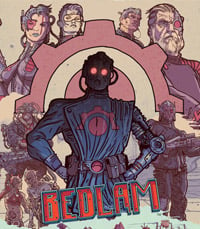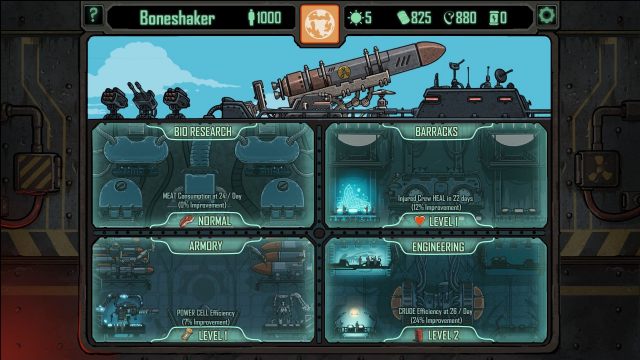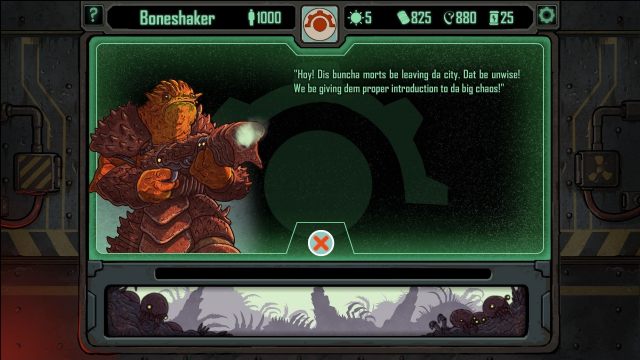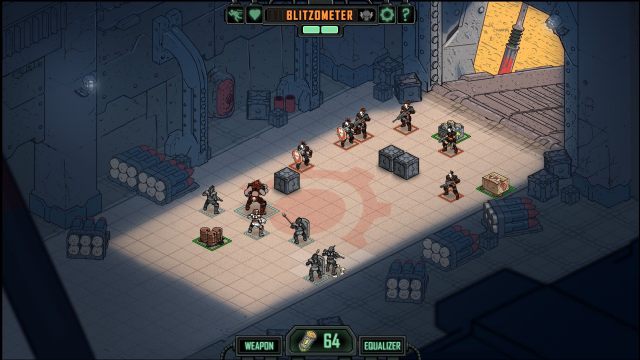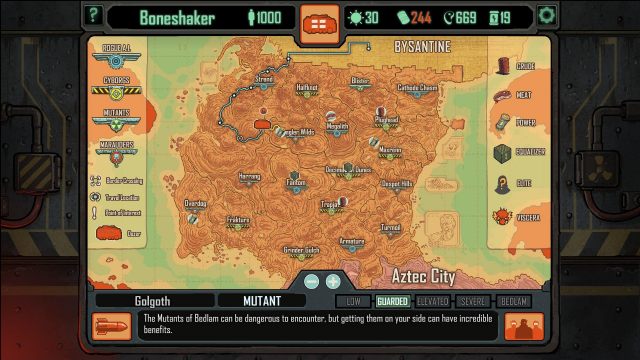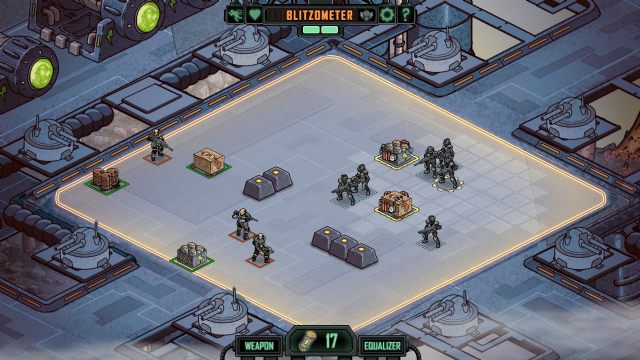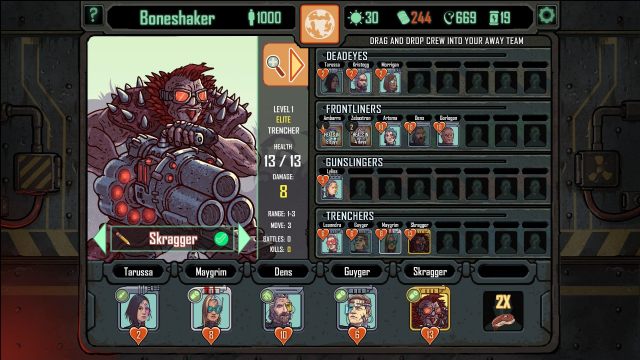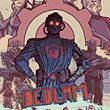Skyshine’s Bedlam Review – roguelike Borderlands on The Banner Saga’s engine
Skyshine’s Bedlam takes us to a wasteland, somewhere between Mad Max and Borderlands. This time, however, not as a lonesome wanderer, but as a boss to an undertaking with thousands of lives at stake.
The review is based on the PC version.

- visuals;
- the „one more turn” syndrome;
- well-written side-quests.
- poorly balanced difficulty level;
- ill-conceived combat mechanics;
- no option to recruit mercenaries.
As Albert Einstein once said, “I know not with what weapons World War III will be fought, but World War IV will be fought with sticks and stones.” For now, we don’t know if there’s a new World War in store for us, but the “nuclear post-apocalypse” setting proved itself to be a charming source material for many game developers. Charming, but often lacking the element of originality. What I mean is that as the background you need a desert, you add some raider gangs, mutants, not enough resources to sustain any form of organized community, and then slap some rogue AI on it and there, you’re done. There’s a plethora of titles, encompassing various media, that duplicate that pattern: the movie Mad Max, the Freeway Warrior gamebooks, Fallout franchise, Neuroshima tabletop RPG… and the list goes on. The newest addition: Skyshine’s Bedlam, a roguelike mix of Borderlands’ style with XCOM’s gameplay mechanics, originating from Kickstarter.
The player is placed in command of a giant, armed and heavily armored ark, referred to as “dozer”, and tasked with leading it through the Bedlam wastelands and all the way to Aztec City – a half-mythical place where salvation awaits you. The wasteland you travel is full of hostile groups: rogue AIs, cyborgs, mutants, or just your common raiders. Your journey is carried out as a series of “hops” – you pick a destination from several available points.
The thing is it won’t be possible to visit every corner of the desert, for your fuel and food reserves are limited. These two are the key factors, and if, for example, you run out of fuel during the game, your adventure will end, and you will see a defeat notification screen. The third key factor are the energy cells that allow you to upgrade the dozer and use its armaments against enemies. Reaching every destination of your choosing consumes a set amount of resources. To reduce the consumption you can upgrade one of the four facilities of the ark: armory decreases the cost of energy cells necessary for subsequent investments, laboratory reduces food consumption, better engine room helps save fuel, and barracks – your manpower. The idea is good, and several different ways to upgrade your land fortress are completely justifiable. Overall, micromanagement may be the best aspect of the game – it is logical, well-designed and offers a significant amount of enjoyment as the game progresses.
The game’s scenario is actually quite nice. Unfortunately, there won’t be many occasions to discover the history of the wasteland and its inhabitants outside of the main storyline that focuses on your road to Aztec City. The map may be full of sub-quests and (mostly interesting) events, but limited resources stand in the way of free exploration, which is a bit of a shame. All the more so, because sometimes accepting an unexpected quest can result in losing the game for no other reason than designer’s arbitrary judgment – you may or may not get some extra fuel, food or additional crew for the dozer. Sometimes you simply fall in some kind of a trap set in the desert. This would be a good moment to mention that Skyshine’s Bedlam is not an easy game. To be honest, even the “easy” difficulty turns out to be anything but. The creators stress that their intent was to maximize the game’s replay value, and if that policy would apply only to the elements I mentioned above, I would have supported their case. Alas, there’s more to it…
Presented in isometric view, and reminding you of The Banner Saga (it’s the same graphic engine after all), the combat is the key feature to this game. That’s unfortunate, because the combat mechanics is the worst part to it - an illogical, irritating and ill-conceived piece of garbage for the making of which its creators should be flayed without a shred of pity. But before we focus on this would-be feature, I need to brief you on the fighting force at your disposal. At the beginning you are given 16 greenhorns divided into four classes: fast, but lacking the punch frontliners, a bit slower but also a bit more effective gunslingers (sporting two revolvers and melee capabilities), even slower, shotgun-wielding trenchers, and deadeyes – basically snipers - nearly stationary but dealing the biggest damage. Now, the thing is, the slower your combatant, the less health he has. Early in the game, a frontliner can take a few hits, but a sniper goes down after a single hit from even the weakest enemies. Believe me, the description still goes easy on the issue - seeing it in action will drive you crazy.
The tactical maps are small, but the execution of gameplay (which could have worked, should the creators have borrowed more mechanics from the XCOM series) went down in flames and the whole thing resembles a bizarre game of chess. The creators’ first mistake: when the fight begins, your forces (from one and up to six men) are placed randomly on the map. You have virtually no saying in who ends up positioned where. During your turn, you are allowed to take two actions with any character under your control, no rocket science there. You can also request support from the dozer if you’d like, but it’s absurdly pricey and a waste of resources when fighting common thugs. All enemies, on the other hand, are given a special reloadable bar for extra action in every turn. That’s outright unfair and throws the whole thing off balance from the start; it is also the very common reason for defeat, in case you need me to explicitly mention it. Still, it’s not the worst thing that you have to face during the combat. The gunmen cannot defend themselves if an enemy gets closer than the minimum effective range of their weapon. The result: your man won’t shoot a charging mutant at point blank with a shotgun.
The field of view works on some alien logic in this game – often you cannot shoot an opponent, apparently standing without any cover, without resorting to some strange L-shaped movement. In contrast, when your men take cover, it will sometimes be completely ineffective. Even more than ineffective, because it stops your character’s shots! Meanwhile, the bandits have no problems making Swiss cheese from the poor guy. That logically challenged idea, to make the characters with the weakest armor the least mobile ones, and give the enemy three instead of two actions per turn, time after time, throws any chance for a balanced gameplay through the window. The first few skirmishes are a nightmare for your men, and you will be fighting the urge to smash the screen with the keyboard, until at least some of them earn the status of a veteran or an elite (which means surviving and killing a sufficient number of enemies).
I should mention at this point that death in this game is permanent, and your manpower, specifically your gunfighters, is in no way dependant on the ark’s residents. You are driving an armored can full of cowards, is what the developers are apparently trying to say – you may have more than a thousand people on board, and not a single one of them can be recruited. You have to rely on elite opponents who need to be beaten first. When you defeat one of them, he/she joins your ranks healthy and ready to fight for you. Friendship through superior firepower I guess…
Skyshine’s Bedlam promises more than it actually delivers. The game itself makes a decent impression with its cartoonish visuals and some nice music that reminds me of Borderlands. Unfortunately, a decent idea ended up buried under a big, steaming pile of tactical gameplay, to which I took virtually no liking. It’s not that the game’s difficulty level was artificially and purposely inflated and it ended up being completely unbalanced. SB can be conquered and provide entertainment even as it is now, but, to be honest, it’s just another game that used the official release as a beta test opportunity, courtesy of interested gamers. The creators have already announced patches intended to eliminate some of the issues I mentioned in this review. However, after all that I’ve wrote, I have to admit that I sincerely liked the idea and the formula of this game. In spite of all the nonsense, I’ve noticed an urge to play the game once more and finish it more than once (which unlocks the dozers of other nations you first meet on the desert). However, if you’re thinking of buying the game, I’d wait if I were you; should the game improve with time and should the necessary changes to the mechanics be introduced, this game will become a must-have for every roguelike fan.
Skyshine's BEDLAM
Skyshine’s Bedlam Review – roguelike Borderlands on The Banner Saga’s engine
Skyshine’s Bedlam takes us to a wasteland, somewhere between Mad Max and Borderlands. This time, however, not as a lonesome wanderer, but as a boss to an undertaking with thousands of lives at stake.
